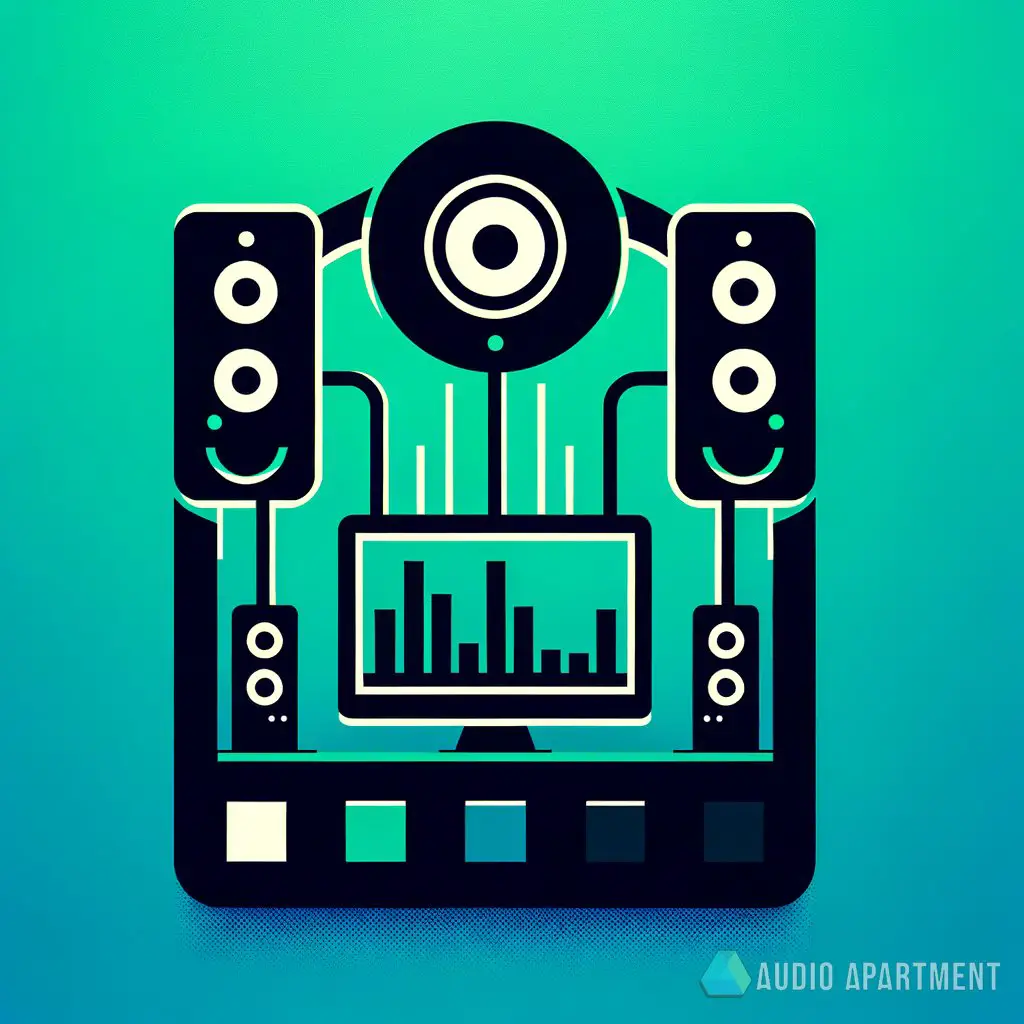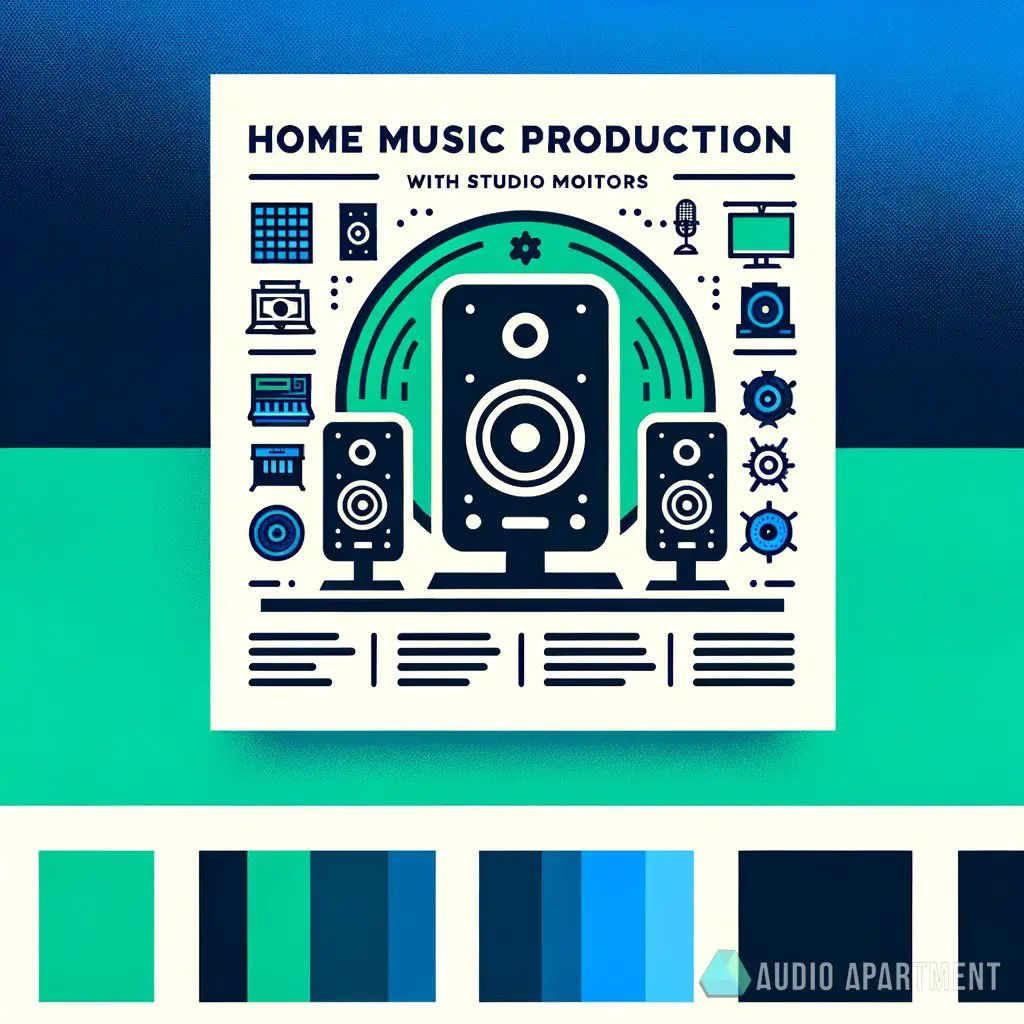Diving into the world of home studios, the debate on the best studio monitors can get as hot as a fresh vinyl on the press. But why are crisp highs and booming lows causing such a stir?
You’ll groove through the nuances of studio monitors, ensuring your mix hits just right.
Key takeaways
- Yamaha HS8s offer a reliable and transparent mix.
- The KRK Rokit 5 G4 adapts to various acoustic environments.
- Adam Audio A7X brings exceptional high-end clarity.
- Room acoustics significantly affect monitor performance.
How can you tell which studio monitors will take your sound to the next level?
When you’re laying down tracks in your home studio, the monitor choice is crucial—it’s like choosing the perfect cocktail ingredients; you need quality to produce the best mix. Here’s a curated selection of top-tier studio monitors that will resonate with everything from gritty guitar riffs to tight hip-hop beats.

These keen contenders consider frequency range, clarity, and of course, the vibe they’ll bring to your studio space.
1. Yamaha HS8
The Yamaha HS8s are the modern successors of the legendary NS10s, providing an honest flat response for critical listening. Their 8-inch cones offer deep, accurate bass, and the 1-inch dome tweeter ensures detailed highs.
With a frequency response that’s as smooth as a well-aged whiskey, you can trust these monitors to give you a transparent mix. If you’re into essential audio mixing techniques, the HS8s are a solid partner.
These white-coned wonders are particularly adored by home studio producers for their true sound reproduction, making your mix transitions as crisp as autumn in Central Park. Plus, their sleek design will make your studio look as professional as it sounds.
For real, if you’re about that mix life, the HS8s deserve your attention.
2. KRK Rokit 5 G4
Rolling in with a reputation that slaps, the KRK Rokit 5 G4 monitors bring the heat with a built-in DSP-driven Graphic EQ. These compact powerhouses adapt to your acoustic environment like a chameleon, making them ideal if your home studio doubles as your living space.
You can’t deny their iconic yellow cones and the bass response that’s as thicc as New York-style pizza.
Let’s not overlook the fact that these are smart monitors. I mean, we’re talking room correction tech that tailors the sound to your space.
Whether you’re mixing down some old-school rock or laying beats for your next hip-hop project, the G4s ensure you do it with precision. And when it comes to equipment that complements your monitors, you can’t go wrong checking out the best MIDI controllers to complete your setup.
3. Adam Audio A7X
Adam Audio A7X monitors are the choice when you’re looking for detail as intricate as a bartender’s garnish. Praised for their X-ART tweeters, these beauts offer startling high-end clarity while their 7-inch woofers kick out a low end that’s tighter than a well-tuned snare.
Frequencies come alive, making these monitors a home studio must.
The A7X stands out not just for its aural precision, but also for its sleek design that brings a vibe check to any studio setting. Covering a broad frequency spectrum, they promise to make your mixing process as smooth as 90s alternative rock.
When talking shop about the best DAWs, Adam Audio’s A7X monitors are always a part of the conversation for a good reason—they just get it.
4. Neumann KH 120 A
Talk about major BDE, the Neumann KH 120 A monitors pack unrivaled acoustic performance in a compact size. These monitors are precisely engineered, and just like that meticulous bartender who knows his craft, the KH 120 As deliver sound that’s as balanced as a well-mixed Manhattan.
With their Mathematically Modeled Dispersion waveguide, you get sound dispersion that’s consistent AF.
In the home studio, space can be tight, but these Neumanns got your back, giving you studio-quality sound that doesn’t require a huge room. They’re the sip tea monitors, perfect for kicking back and critically listening to your latest tracks or mastering your next big hit.
And let’s not forget, hooking them up with top studio headphones can make a night and day difference in your production process.
5. Genelec 8010A
Genelec 8010As are like the secret sauce in your sonic burger—they’re small but pack a punch that’s as lit as a Friday night in the East Village. With their Minimum Diffraction Enclosure, these tiny titans deliver amazing sound with a broad sweet spot.
Ideal for mixing on the go or in a compact urban space, they’re as versatile as your favorite leather jacket.
“The Yamaha HS8s are the modern successors of the legendary NS10s, providing an honest flat response for critical listening. Their 8-inch cones offer deep, accurate bass, and the 1-inch dome tweeter ensures detailed highs.With a frequency response that’s as smooth as a well-aged whiskey, you can trust these monitors to give you a transparent mix.”
Now don’t let their size fool you; these monitors are robust, with an accurate low end that defies their dimensions. And for those late-night mixing sessions, their Intelligent Signal Sensing tech saves energy by automatically powering down when not in use.
Pair them up with some stellar microphones, and you’re on track to produce sound that cuts through the noise like a knife through hot butter.
More studio monitor setup tips
A solid studio monitor setup can truly elevate your production game, just like the perfect garnish to a cocktail. Besides choosing the right monitors, there are other crucial steps to enhance your audio experience.
- Ensure your studio space is acoustically treated to reduce unwanted reverberations and reflections.
- Position your studio monitors at ear level and set them apart at an equal distance from each other to create an ideal sweet spot.
- Break in your new monitors with a variety of music to ensure all components are properly flexed and ready for mixing.
Take a beat to consider the dos and don’ts of setting up studio monitors as well:
| Do | Don’t |
|---|---|
| Use monitor stands to isolate the speakers from surfaces. | Place monitors directly on the desk to avoid vibrations and distorted sound. |
| Keep the monitors away from walls to minimize bass frequency build-up. | Push monitors against walls or corners which can color the sound. |
| Adjust the volume to a comfortable level to protect your hearing. | Mix at high volumes for extended periods to avoid ear fatigue and potential hearing damage. |
| Refer to the manufacturer’s manual for specifics on calibration and setup. | Assume all monitors work the same and skip reading the manual. |
This table serves as a quick reference to optimizing your studio monitor setup for a clear and accurate sound.
Advantages and disadvantages of studio monitors
Choosing the right studio monitors is akin to selecting the best instruments for a band; it can make or break the sound of your final mix. Let’s sift through the pros and cons to better understand how studio monitors can affect your music production workflow.

Advantages
- Studio monitors provide a flat frequency response for an accurate mix.
- They reveal imperfections in recordings, allowing for precise editing and mixing.
- Well-placed studio monitors can create an ideal stereo image for critical listening.
Disadvantages
- High-end studio monitors can be expensive, especially for those just starting out.
- Without proper acoustic treatment, even the best monitors won’t perform to their potential.
- They are less forgiving, exposing every flaw in a mix, which can be discouraging to novice producers.
As a burgeoning amateur on the production scene, I’ve got to say, the deep dive into studio monitors is a mix of excitement and intimidation. From what I’ve gathered, the journey to finding the right monitor feels a lot like crafting the perfect playlist—it’s personal, and there’s no one-size-fits-all.
My mixes are leaning towards classic rock and hip-hop, so I reckon something like the KRK Rokit 5 G4 would give me that robust bass and clear highs I’m looking for. That being said, opinions are like favorite records: everyone’s got one, and they’re all different.
Speaking of personal takes, I’ve noticed that studio monitors are as much about feel as they are about sound. When my friends and I chill and talk gear, the convo usually turns to how the sound impacts our creative flow.
I don’t have the creds of a pro audio engineer, but I do know that monitors like the Adam Audio A7X have this way of unveiling the depth in my tracks that I never knew existed. If you’re looking to amp up your setup, check out some best DAWs for home studios and see how they can complement your monitors of choice.
If you are a visual learner, check out this video titled ‘Top 5 Studio Monitors For Home Studios 2023’
Frequently asked questions (FAQ)
How important is room treatment when using studio monitors?
Room treatment is crucial. It’s like the difference between sipping a cocktail in a dive bar versus a speakeasy; each gives a different vibe.
Proper acoustic treatment reduces reflections and standing waves, allowing your monitors to perform at their best. Think of it as fine-tuning your room to match the fidelity of your monitors, so you capture the true essence of your sound.
Can I use regular speakers as studio monitors?
Regular speakers and studio monitors play different gigs. Standard speakers usually hype certain frequencies to make music sound better, like an Instagram filter.
Studio monitors, however, are the raw, unfiltered photo—they provide a flat and neutral sound so you can judge your mix accurately. Stick with monitors for mixing, and save the regular speakers for casual listening.
How far apart should my studio monitors be placed?
Imagine drawing an equilateral triangle with your head and the two monitors as the corners. That’s your goal for placement.
Typically, the monitors should be placed about 3 to 4 feet apart, depending on your room and monitor size. Giving them enough space allows for a proper stereo image and helps you pinpoint where instruments sit in the mix.
Final thoughts
As we wrap up this sonic journey through the world of home studio monitors, it’s clear that the right choice can have as much impact on your sound as dropping the needle on a classic album. Whether you’re a novice producer or a seasoned mixer, understanding the nuances of your monitors can turn good tracks into great ones.
The monitors we’ve explored are proven to deliver a mix that’s true to your artistic vision. So go ahead, turn up that dial and let the music play.
What’s your next step in achieving the perfect home studio sound? Did I cover everything you wanted to know? Let me know in the comments section below;I read and reply to every comment. If you found this article helpful, share it with your friends, and check out my full blog for more tips and tricks on mastering your music.
Thanks for reading, and here’s to your next chart-topping track.
















